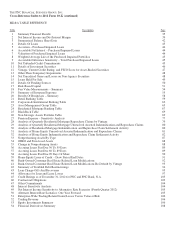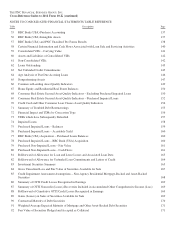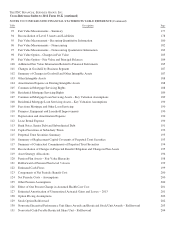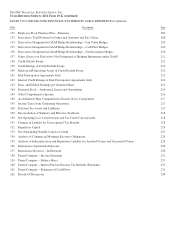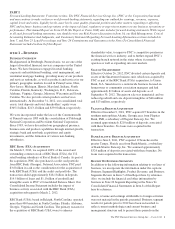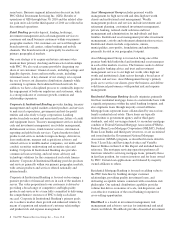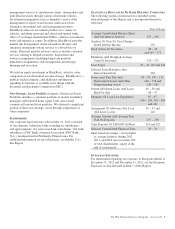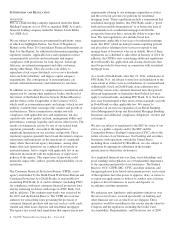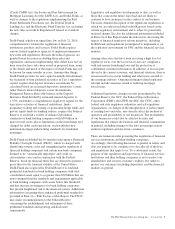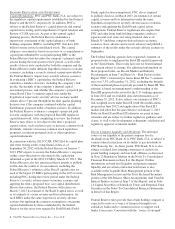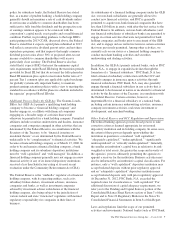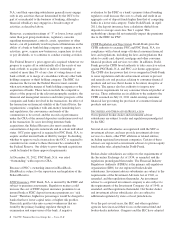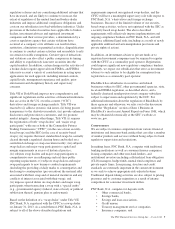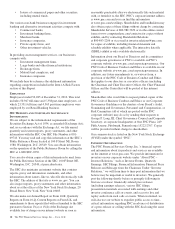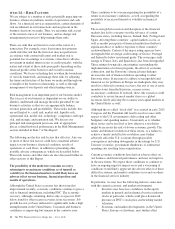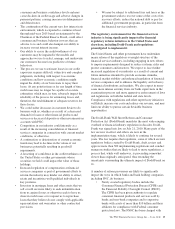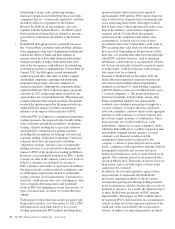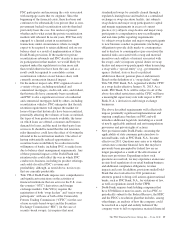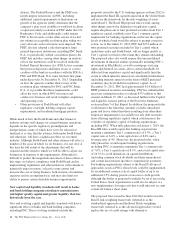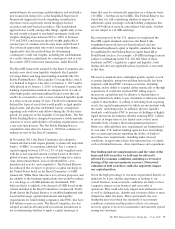PNC Bank 2012 Annual Report Download - page 26
Download and view the complete annual report
Please find page 26 of the 2012 PNC Bank annual report below. You can navigate through the pages in the report by either clicking on the pages listed below, or by using the keyword search tool below to find specific information within the annual report.
policy for subsidiary banks, the Federal Reserve has stated
that, as a matter of prudent banking, a bank holding company
generally should not maintain a rate of cash dividends unless
its net income available to common shareholders has been
sufficient to fully fund the dividends and the prospective rate
of earnings retention appears to be consistent with the
corporation’s capital needs, asset quality and overall financial
condition. Further, in providing guidance to the large BHCs
participating in the 2013 CCAR, discussed above, the Federal
Reserve stated that it expects capital plans submitted in 2013
will reflect conservative dividend payout ratios and net share
repurchase programs, and that requests that imply common
dividend payout ratios above 30% of projected after-tax net
income available to common shareholders will receive
particularly close scrutiny. The Federal Reserve also has
stated that it expects BHCs that meet the minimum capital
ratio requirements under Basel III during the transition periods
provided by Basel III, but that do not meet the fully-phased in
Basel III minimum plus capital conservation buffer ratio of 7
percent Tier 1 common (plus any applicable capital surcharge
for globally systemically important banks), to maintain
prudent earnings retention policies with a view to meeting this
standard in accordance with the phase-in schedule included in
the agencies’ proposed Basel III rules.
Additional Powers Under the GLB Act. The Gramm–Leach–
Bliley Act (GLB Act) permits a qualifying bank holding
company to become a “financial holding company” and
thereby engage in, or affiliate with financial companies
engaging in, a broader range of activities than would
otherwise be permitted for a bank holding company. Permitted
affiliates include securities underwriters and dealers, insurance
companies and companies engaged in other activities that are
determined by the Federal Reserve, in consultation with the
Secretary of the Treasury, to be “financial in nature or
incidental thereto” or are determined by the Federal Reserve
unilaterally to be “complementary” to financial activities. We
became a financial holding company as of March 13, 2000. In
order to be and remain a financial holding company, a bank
holding company and its subsidiary depository institutions
must be “well capitalized” and “well managed.” In addition, a
financial holding company generally may not engage in a new
financial activity if any of its insured depository institutions
received a less than Satisfactory rating at its most recent
evaluation under the Community Reinvestment Act (CRA).
The Federal Reserve is the “umbrella” regulator of a financial
holding company, with its operating entities, such as its
subsidiary broker-dealers, investment advisers, insurance
companies and banks, as well as investment companies
advised by investment adviser subsidiaries of the financial
holding company, also being subject to the jurisdiction of
various federal and state “functional” regulators with normal
regulatory responsibility for companies in their lines of
business.
As subsidiaries of a financial holding company under the GLB
Act, our non-bank subsidiaries are generally allowed to
conduct new financial activities, and PNC is generally
permitted to acquire non-bank financial companies that have
less than $10 billion in assets, with after-the-fact notice to the
Federal Reserve. In addition, our non-bank subsidiaries (and
any financial subsidiaries of subsidiary banks) are permitted to
engage in certain activities that were not permitted for bank
holding companies and banks prior to enactment of the GLB
Act, and to engage on less restrictive terms in certain activities
that were previously permitted. Among other activities, we
currently rely on our status as a financial holding company to
conduct merchant banking activities and securities
underwriting and dealing activities.
In addition, the GLB Act permits national banks, such as PNC
Bank, N.A., to engage in expanded activities through the
formation of a “financial subsidiary.” PNC Bank, N.A. has
filed a financial subsidiary certification with the OCC and
currently engages in insurance agency activities through
financial subsidiaries. PNC Bank, N.A. may also generally
engage through a financial subsidiary in any activity that is
determined to be financial in nature or incidental to a financial
activity by the Secretary of the Treasury, in consultation with
the Federal Reserve. Certain activities, however, are
impermissible for a financial subsidiary of a national bank,
including certain insurance underwriting activities, insurance
company investment activities, real estate investment or
development, and merchant banking.
Other Federal Reserve and OCC Regulation and Supervision.
The federal banking agencies possess broad powers to take
corrective action as deemed appropriate for an insured
depository institution and its holding company. In some cases,
the extent of these powers depends upon whether the
institution in question is considered “well capitalized,”
“adequately capitalized,” “undercapitalized,” “significantly
undercapitalized” or “critically undercapitalized.” Generally,
the smaller an institution’s capital base in relation to its risk-
weighted or total assets, the greater the scope and severity of
the agencies’ powers, ultimately permitting the agencies to
appoint a receiver for the institution. Business activities may
also be influenced by an institution’s capital classification. For
instance, only a “well capitalized” depository institution may
accept brokered deposits without prior regulatory approval
and an “adequately capitalized” depository institution may
accept brokered deposits only with prior regulatory approval.
At December 31, 2012, PNC Bank, N.A. exceeded the
required ratios for classification as “well capitalized.” For
additional discussion of capital adequacy requirements, we
refer you to the Funding and Capital Sources portion of the
Consolidated Balance Sheet Review section of Item 7 of this
Report and to Note 22 Regulatory Matters in the Notes To
Consolidated Financial Statements in Item 8 of this Report.
Laws and regulations limit the scope of our permitted
activities and investments. National banks (such as PNC Bank,
The PNC Financial Services Group, Inc. – Form 10-K 7


